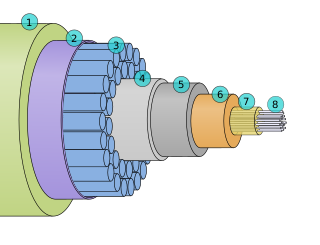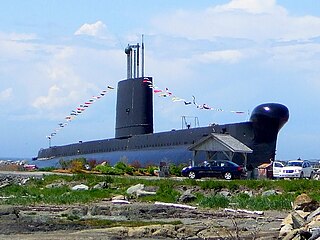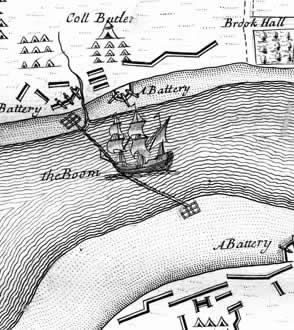Related Research Articles

A boat is a watercraft of a large range of types and sizes, but generally smaller than a ship, which is distinguished by its larger size, shape, cargo or passenger capacity, or its ability to carry boats.

A submarine is a watercraft capable of independent operation underwater. It differs from a submersible, which has more limited underwater capability. The term is also sometimes used historically or colloquially to refer to remotely operated vehicles and robots, as well as medium-sized or smaller vessels, such as the midget submarine and the wet sub. Submarines are referred to as boats rather than ships irrespective of their size.

Sonar is a technique that uses sound propagation to navigate, measure distances (ranging), communicate with or detect objects on or under the surface of the water, such as other vessels.

A submarine communications cable is a cable laid on the sea bed between land-based stations to carry telecommunication signals across stretches of ocean and sea. The first submarine communications cables laid beginning in the 1850s carried telegraphy traffic, establishing the first instant telecommunications links between continents, such as the first transatlantic telegraph cable which became operational on 16 August 1858.

Underwater archaeology is archaeology practiced underwater. As with all other branches of archaeology, it evolved from its roots in pre-history and in the classical era to include sites from the historical and industrial eras. Its acceptance has been a relatively late development due to the difficulties of accessing and working underwater sites, and because the application of archaeology to underwater sites initially emerged from the skills and tools developed by shipwreck salvagers. As a result, underwater archaeology initially struggled to establish itself as actual archaeological research. This changed when universities began teaching the subject and a theoretical and practical base for the sub-discipline was firmly established in the late 1980s. Underwater archaeology now has a number of branches including, maritime archaeology: the scientifically based study of past human life, behaviours and cultures and their activities in, on, around and (lately) under the sea, estuaries and rivers. This is most often effected using the physical remains found in, around or under salt or fresh water or buried beneath water-logged sediment. In recent years, the study of submerged WWII sites and of submerged aircraft in the form of underwater aviation archaeology have also emerged as bona fide activity.
A torpedo tube is a cylindrical device for launching torpedoes.

HMCS Onondaga (S73) is an Oberon-class submarine that served in the Royal Canadian Navy and later the Canadian Forces. Built in the mid-1960s, Onondaga operated primarily with the Maritime Forces Atlantic until her decommissioning in 2000 as the last Canadian Oberon.

The Gotland-class submarines of the Swedish Navy are modern diesel-electric submarines, which were designed and built by the Kockums shipyard in Sweden. They are the first submarines in the world to feature a Stirling engine air-independent propulsion (AIP) system, which extends their underwater endurance from a few days to weeks. This capability had previously only been available with nuclear-powered submarines.

The British U-class submarines were a class of 49 small submarines built just before and during the Second World War. The class is sometimes known as the Undine class, after the first submarine built. A further development was the British V-class submarine of 1942.

Pitometer logs are devices used to measure a ship's speed relative to the water. They are used on both surface ships and submarines. Data from the pitometer log is usually fed directly into the ship's navigation system.
Underwater logging is the process of logging trees from underwater forests. When artificial reservoirs and dams are built, large areas of forest are often inundated; although the trees die, the wood is often preserved. The trees can then be felled using special underwater machinery and floated up to the surface. One such machine is the sawfish harvester. There is an ongoing debate to determine whether or not underwater logging is a sustainable practice and if it is more environmentally sustainable than traditional logging.

HMS P38 was a Royal Navy U-class submarine built by Vickers-Armstrong at Barrow-in-Furness.
An Electromagnetic Log, sometimes called an "EM Log", measures the speed of a vessel through water.

The McCann Submarine Rescue Chamber is a device for rescuing submariners from a submarine that is unable to surface.
In the United States Navy, Refueling and Overhaul (ROH) refers to a lengthy refitting process or procedure performed on nuclear-powered naval ships, which involves replacement of expended nuclear fuel with new fuel and a general maintenance fix-up, renovation, and often modernization of the entire ship. In theory, such a process could simply involve only refueling or only an overhaul, but in practice, nuclear refueling is always combined with an overhaul. An ROH usually takes one to two years for submarines and up to almost three years for an aircraft carrier, performed at a naval shipyard. Time periods between ROHs on a ship have varied historically from about 5–20 years to up to 25 years. For modern submarines and aircraft carriers, ROHs are typically carried out about midway through their operating lifespan. There are also shorter maintenance fix-ups called availabilities for ships periodically at shipyards. A particularly lengthy refueling, maintenance, and modernization process for a nuclear aircraft carrier can last up to almost three years and be referred to as a Refueling Complex Overhaul (RCOH).

The Torpedo Data Computer (TDC) was an early electromechanical analog computer used for torpedo fire-control on American submarines during World War II. Britain, Germany, and Japan also developed automated torpedo fire control equipment, but none were as advanced as the US Navy's TDC, as it was able to automatically track the target rather than simply offering an instantaneous firing solution. This unique capability of the TDC set the standard for submarine torpedo fire control during World War II.

A boom or a chain is an obstacle strung across a navigable stretch of water to control or block navigation.
The following index is provided as an overview of and topical guide to Wikipedia's articles on recreational dive sites. The level of coverage may vary:

Recreational dive sites are specific places that recreational scuba divers go to enjoy the underwater environment or for training purposes. They include technical diving sites beyond the range generally accepted for recreational diving. In this context all diving done for recreational purposes is included. Professional diving tends to be done where the job is, and with the exception of diver training and leading groups of recreational divers, does not generally occur at specific sites chosen for their easy access, pleasant conditions or interesting features.
Submarine rescue is the process of locating a sunk submarine with survivors on board, and bringing the survivors to safety. This may be done by recovering the vessel to the surface first, or by transferring the trapped personnel to a rescue bell or deep-submergence rescue vehicle to bring them to the surface. Submarine rescue may be done at pressures between ambient at depth, and sea level atmospheric pressure, depending on the condition of the distressed vessel and the equipment used for the rescue. Self-rescue of submarine personnel by buoyant free ascent at ambient pressure is considered submarine escape. Survivors may require recompression treatment for decompression illness.
References
- ↑ "Underwater Log Systems". USS Bowfin Submarine Museum & Park. 2002. Archived from the original on 2006-08-25. Retrieved 2006-08-26.